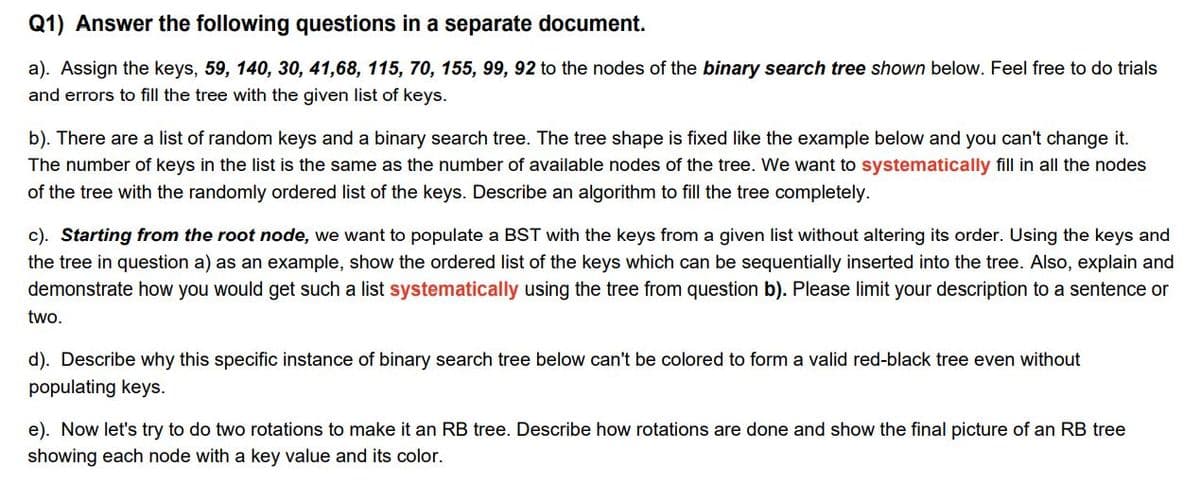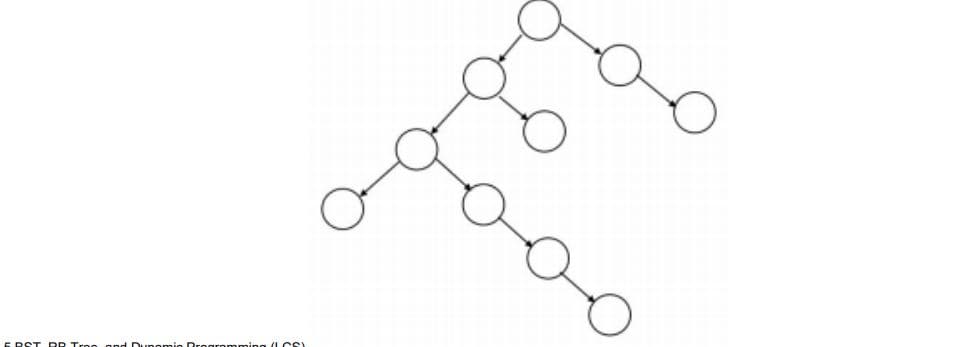a). Assign the keys, 59, 140, 30, 41,68, 115, 70, 155, 99, 92 to the nodes of the binary search tree shown below. Feel free to do trials and errors to fill the tree with the given list of keys. b). There are a list of random keys and a binary search tree. The tree shape is fixed like the example below and you can't change it. The number of keys in the list is the same as the number of available nodes of the tree. We want to systematically fill in all the nodes of the tree with the randomly ordered list of the keys. Describe an algorithm to fill the tree completely. c). Starting from the root node, we want to populate a BST with the keys from a given list without altering its order. Using the keys and the tree in question a) as an example, show the ordered list of the keys which can be sequentially inserted into the tree. Also, explain and demonstrate how you would get such a list systematically using the tree from question b). Please limit your description to a sentence or two. d). Describe why this specific instance of binary search tree below can't be colored to form a valid red-black tree even without populating keys. e). Now let's try to do two rotations to make it an RB tree. Describe how rotations are done and show the final picture of an RB tree showing each node with a key value and its color.
a). Assign the keys, 59, 140, 30, 41,68, 115, 70, 155, 99, 92 to the nodes of the binary search tree shown below. Feel free to do trials and errors to fill the tree with the given list of keys. b). There are a list of random keys and a binary search tree. The tree shape is fixed like the example below and you can't change it. The number of keys in the list is the same as the number of available nodes of the tree. We want to systematically fill in all the nodes of the tree with the randomly ordered list of the keys. Describe an algorithm to fill the tree completely. c). Starting from the root node, we want to populate a BST with the keys from a given list without altering its order. Using the keys and the tree in question a) as an example, show the ordered list of the keys which can be sequentially inserted into the tree. Also, explain and demonstrate how you would get such a list systematically using the tree from question b). Please limit your description to a sentence or two. d). Describe why this specific instance of binary search tree below can't be colored to form a valid red-black tree even without populating keys. e). Now let's try to do two rotations to make it an RB tree. Describe how rotations are done and show the final picture of an RB tree showing each node with a key value and its color.
Database System Concepts
7th Edition
ISBN:9780078022159
Author:Abraham Silberschatz Professor, Henry F. Korth, S. Sudarshan
Publisher:Abraham Silberschatz Professor, Henry F. Korth, S. Sudarshan
Chapter1: Introduction
Section: Chapter Questions
Problem 1PE
Related questions
Question

Transcribed Image Text:Q1) Answer the following questions in a separate document.
a). Assign the keys, 59, 140, 30, 41,68, 115, 70, 155, 99, 92 to the nodes of the binary search tree shown below. Feel free to do trials
and errors to fill the tree with the given list of keys.
b). There are a list of random keys and a binary search tree. The tree shape is fixed like the example below and you can't change it.
The number of keys in the list is the same as the number of available nodes of the tree. We want to systematically fill in all the nodes
of the tree with the randomly ordered list of the keys. Describe an algorithm to fill the tree completely.
c). Starting from the root node, we want to populate a BST with the keys from a given list without altering its order. Using the keys and
the tree in question a) as an example, show the ordered list of the keys which can be sequentially inserted into the tree. Also, explain and
demonstrate how you would get such a list systematically using the tree from question b). Please limit your description to a sentence or
two.
d). Describe why this specific instance of binary search tree below can't be colored to form a valid red-black tree even without
populating keys.
e). Now let's try to do two rotations to make it an RB tree. Describe how rotations are done and show the final picture of an RB tree
showing each node with a key value and its color.

Transcribed Image Text:ERST PR Tree ond Dynemie Dregromming (LCS)
Expert Solution
This question has been solved!
Explore an expertly crafted, step-by-step solution for a thorough understanding of key concepts.
This is a popular solution!
Trending now
This is a popular solution!
Step by step
Solved in 2 steps with 3 images

Knowledge Booster
Learn more about
Need a deep-dive on the concept behind this application? Look no further. Learn more about this topic, computer-science and related others by exploring similar questions and additional content below.Recommended textbooks for you

Database System Concepts
Computer Science
ISBN:
9780078022159
Author:
Abraham Silberschatz Professor, Henry F. Korth, S. Sudarshan
Publisher:
McGraw-Hill Education

Starting Out with Python (4th Edition)
Computer Science
ISBN:
9780134444321
Author:
Tony Gaddis
Publisher:
PEARSON

Digital Fundamentals (11th Edition)
Computer Science
ISBN:
9780132737968
Author:
Thomas L. Floyd
Publisher:
PEARSON

Database System Concepts
Computer Science
ISBN:
9780078022159
Author:
Abraham Silberschatz Professor, Henry F. Korth, S. Sudarshan
Publisher:
McGraw-Hill Education

Starting Out with Python (4th Edition)
Computer Science
ISBN:
9780134444321
Author:
Tony Gaddis
Publisher:
PEARSON

Digital Fundamentals (11th Edition)
Computer Science
ISBN:
9780132737968
Author:
Thomas L. Floyd
Publisher:
PEARSON

C How to Program (8th Edition)
Computer Science
ISBN:
9780133976892
Author:
Paul J. Deitel, Harvey Deitel
Publisher:
PEARSON

Database Systems: Design, Implementation, & Manag…
Computer Science
ISBN:
9781337627900
Author:
Carlos Coronel, Steven Morris
Publisher:
Cengage Learning

Programmable Logic Controllers
Computer Science
ISBN:
9780073373843
Author:
Frank D. Petruzella
Publisher:
McGraw-Hill Education